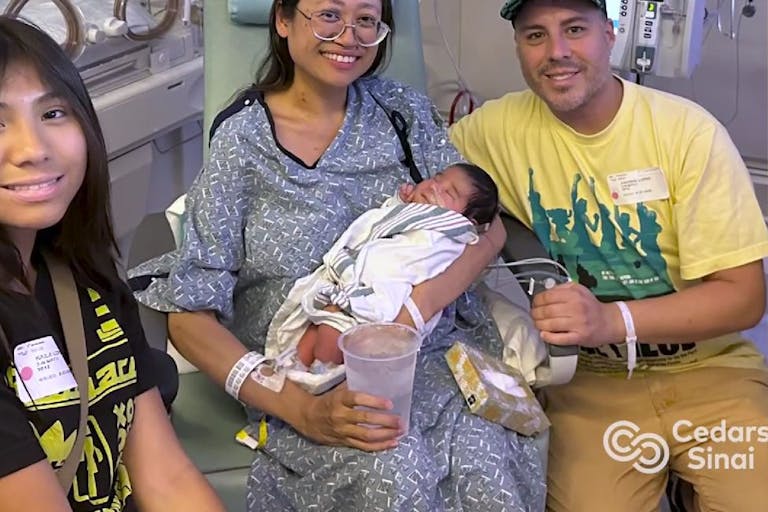
Full term 'miracle' baby born after 'unprecedented' ectopic pregnancy
Bridget Sielicki
·
FACT CHECK: Is doctor’s failed, fatal miscarriage treatment the fault of Texas’ pro-life law?
A tragic story of the death of 35-year-old Porsha Ngumezi in Texas is being exploited to claim that pro-life laws protecting preborn children from abortion are harming women. Just as with the previous four stories shared across media outlets (Amber Thurman, Candi Miller, Josseli Barnica, Nevaeh Crain), the details don’t line up with this false narrative.
Dishonest media continues to post headlines meant to shock, using phrases about such deaths being “preventable” — but according to maternal death reports from even pro-abortion states, the vast majority of pregnancy-related deaths each year are preventable — regardless of what state a woman lives in or what the laws are.
These media outlets, of course, are leaving out this important detail. They’re also now attempting to conflate miscarriage care with abortion, with even local Texas news outlet KVUE inexplicably referring to miscarriage treatment as “abortion-related care.” If miscarriage care were the same as abortion or “abortion-related care,” Planned Parenthood wouldn’t be able to legally offer it in Texas… and yet, Planned Parenthood offers it — even in Houston, where Porsha died.
At a Glance:
Porsha Ngumezi was experiencing bleeding in early pregnancy and passing large clots. She also had a blood clotting disorder.
After several hours and two blood transfusions, the on-call OB/GYN prescribed misoprostol to help complete the miscarriage, which was the method Porsha preferred over a surgical D&C. The doctor explained a D&C would be necessary if the misoprostol didn’t work.
Several doctors believe Porsha needed a D&C to complete her miscarriage but claim doctors in Texas were too afraid to carry out the procedure due to the state’s pro-life law.
The OB/GYN who oversaw her care is alleged to have falsified documentation after her death.
Porsha died at the hospital just hours after taking misoprostol.
Porsha’s story
Porsha was the mother of two young sons with her husband Hope Ngumezi when she learned they were expecting their third child. Porsha made an appointment for weeks later, what was estimated to be around the 11-week mark of pregnancy. But before she made it to that first prenatal visit, she began to experience spotting. Her doctor advised her to visit an ER should the bleeding worsen.
On June 11, 2023, Porsha drove herself to the ER of Houston Methodist Sugar Land. At the ER, a radiologist confirmed through ultrasound that there was a pregnancy sac, but no heartbeat and no embryo to be seen. The radiologist noted Porsha had “a pregnancy of an unknown location.” When there is a “sac-like structure” as the radiologist noted, but no visible baby at 10-11 weeks, this is a sign of an anembryonic pregnancy (blighted ovum), one of the more common types of miscarriage. This occurs when the embryo never forms or stops forming but attaches to the uterine wall. Pregnancy hormones can continue to be released for some time.
Dr. Andrew Ryan Davis was the on-call OB/GYN, and an ER doctor contacted him to discuss the ultrasound. They agreed to observe Porsha in the hospital and monitor the bleeding. Doctors were allegedly aware that Porsha had a blood clotting disorder.
At 6:30, three hours after she arrived, the ER doctor documented “significant bleeding.” Porsha texted her husband to say that the medical staff told her she might need surgery to complete the miscarriage.
By 8:30 that evening, Hope arrived to meet his wife Porsha, who had passed out. Her blood pressure was dropping, said ProPublica, but she had been refusing a blood transfusion. Now that her husband had arrived, she agreed to one and then a second.
Over the course of six hours at the hospital, Porsha had been hemorrhaging and “passing large clots the size of grapefruit,” according to one nurse.
ProPublica said that the doctors who later reviewed Porsha’s medical documents on the news outlet’s behalf said it was “clear she needed a D&C.” (The doctors consulted by ProPublica included Daniel Grossman, an abortionist/activist who has suggested that medical personnel at emergency rooms should falsify medical documents to cover up abortion pill complications. He has also openly advocated for over-the-counter abortion pills despite the risks to women.)
At 9:45 pm, a nurse documented that Porsha was “continuing to pass large clots the size of grapefruit.” But Davis allegedly had signaled that he wanted to move her to a different floor of the hospital. At 10:20 pm, Davis arrived to see Porsha. That’s when he prescribed misoprostol, reportedly saying it was “routine” at Houson Methodist for missed miscarriage care.
Misoprostol is one of the options available for a “missed” or “incomplete” miscarriage in which not all of the embryonic remains or pregnancy tissue are successfully passed by the mother. At the first signs of miscarriage, it is typical for doctors to “watch and wait” to see if the miscarriage completes on its own. If it doesn’t, the doctor may prescribe misoprostol or a D&C depending on the woman’s situation. (Both misoprostol and the D&C procedure are also used during induced abortions that are carried out to intentionally kill a preborn child.) In a missed miscarriage, in which the baby has no heartbeat (as was the case with Porsha’s baby), neither misoprostol nor a D&C is considered an abortion, nor is either considered illegal; in miscarriage care cases, these treatments are not being used to intentionally kill a child (who has already died), but to protect the mother’s life and health.
According to Texas Children’s “Managing Miscarriage” document, a D&C takes just five to ten minutes and carries some risks including hemorrhage, scarring, perforated uterus, and infection. Bleeding may last for up to three weeks. The document also says that “medical management” of a missed miscarriage involves two drugs (likely mifepristone and misoprostol) and can take a couple of days. Risks include infection and bleeding that can last for up to three weeks. Some women will still need a D&C.
Hope told ProPublica that Davis explained to the couple that if the misoprostol didn’t work, then surgery (a D&C) would be necessary. ProPublica also noted that, to Porsha, “a pill sounded good… because the idea of surgery scared her.” Her husband, however, claimed that Davis failed to properly explain the details of both treatment options, with the risks and benefits of each.
Porsha’s death
After taking misoprostol, Porsha complained of chest pain, and though her vital signs “looked fine,” according to ProPublica, by 1:30 in the morning, she complained that she could not breathe. She died soon after. The medical examiner determined her cause of death to be hemorrhage.
The doctors with whom ProPublica consulted said Porsha should have been given a D&C instead of misoprostol.
“Misoprostol at 11 weeks is not going to work fast enough,” said Dr. Amber Truehart, an OB-GYN at the pro-abortion University of New Mexico Center for Reproductive Health. “The patient will continue to bleed and have a higher risk of going into hemorrhagic shock.”
Pro-life board-certified OB/GYN Ingrid Skop, Vice President and Director of Medical Affairs for Charlotte Lozier Institute, agrees that a D&C would have been the correct (and entirely legal) treatment. She told Live Action News:
Based on the publicly available details from ProPublica’s reporting, Porsha Ngumezi’s tragic death reflects poor-quality care. She should have received a D&C, which was not prohibited by Texas’ law. When a woman who is bleeding heavily requires a transfusion, as this mother did, she is in the midst of a medical crisis. The bleeding needs to be urgently controlled, and a D&C is the quickest way to stabilize her.
Misoprostol for miscarriage management is appropriate only in a patient who is medically stable. Her physician’s failure to provide the medically necessary intervention reflects very poor-quality care, possibly medical malpractice.
Texas law is very clear: During a pregnancy emergency, physicians may use their “reasonable medical judgment” to determine when to intervene, and the risk of maternal death does not need to be “imminent.”
Leveraging women’s suffering to promote a dishonest and harmful ideological agenda has become standard practice for the pro-abortion lobby. This fearmongering will only harm more women. Texas women deserve better, which is why Texas medical organizations and hospitals need to do better to make sure that every physician understands their duty to provide lifesaving care.
Why didn’t Porsha receive a D&C?
If both pro-abortion and pro-life OB/GYNs agree that Porsha needed a D&C, why wasn’t she given one? That answer remains a mystery. However, it was noted that Porsha requested to try medication first, instead of surgery.
ProPublica, however, argued that Porsha wasn’t given a D&C because “a D&C… attracts more attention from colleagues…” and that “[s]taff are familiar with misoprostol because it’s used for labor, and it only requires a doctor and a nurse to administer it. To do a procedure, on the other hand, a doctor would need to find an operating room, an anesthesiologist and a nursing team.”
Dr. Alison Goulding, an OB/GYN in Houston who previously signed a politically-charged letter to Texas lawmakers, alleged that this meant Davis would have to convince more people that a D&C was not illegal. “Many people may be afraid and misinformed and refuse to participate — even if it’s for a miscarriage,” claimed Goulding.
If this were fact and not speculation, then this would signify that the law is not at fault in Porsha’s death, but the hospital is — because it failed to inform and advise staff on the laws. If its staff are “misinformed” about the law as Goulding suggests, then therein lies the problem. ProPublica said the hospital declined to share its miscarriage protocols “or explain how it is guiding doctors under the abortion ban.”
She added, “Stigma and fear are there for D&Cs in a way that they are not for misoprostol. Doctors assume that a D&C is not standard in Texas anymore, even in cases where it should be recommended. People are afraid: They see D&C as abortion and abortion as illegal.”
Article continues below
Dear Reader,
Have you ever wanted to share the miracle of human development with little ones? Live Action is proud to present the "Baby Olivia" board book, which presents the content of Live Action's "Baby Olivia" fetal development video in a fun, new format. It's perfect for helping little minds understand the complex and beautiful process of human development in the womb.
Receive our brand new Baby Olivia board book when you give a one-time gift of $30 or more (or begin a new monthly gift of $15 or more).
This is a stretch since D&Cs are commonly known to be used in miscarriage treatment and are also used diagnostically on women who are not pregnant.
Why would medical staff think that D&Cs are induced abortions when Texas defines abortion as “the act of using or prescribing an instrument, a drug, a medicine, or any other substance, device, or means with the intent to cause the death of an unborn child of a woman known to be pregnant.” The law also clearly states that an act is “not an abortion if the act is done with the intent to: (A) save the life or preserve the health of an unborn child; (B) remove a dead, unborn child whose death was caused by spontaneous abortion [miscarriage]; or (C) remove an ectopic pregnancy.”
A quick Google search could clear up all of the alleged confusion surrounding what is and isn’t an illegal procedure in Texas. Yet media outlets and abortion advocates continue to produce misleading content that is misleading and confusing people.
In addition, it would seem obvious that doctors would know the difference between induced abortion and miscarriage in hospital codes. Miscarriage is coded as a spontaneous abortion and there are options for delayed or excessive hemorrhaging. There is also a code for hemorrhage in early pregnancy and a code for threatened miscarriage. There are separate codes for complications following an “(induced) termination of pregnancy).”
Potentially falsified documents
ProPublica claims:
Doctors and nurses involved in Porsha’s care did not respond to multiple requests for comment.
Several physicians who reviewed the summary of her case pointed out that Davis’ post-mortem notes did not reflect nurses’ documented concerns about Porsha’s “heavy bleeding.” After Porsha died, Davis wrote instead that the nurses and other providers described the bleeding as “minimal,” though no nurses wrote this in the records. ProPublica tried to ask Davis about this discrepancy. He did not respond to emails, texts or calls.
Houston Methodist officials declined to answer a detailed list of questions about Porsha’s treatment. They did not comment when asked whether Davis’ approach was the hospital’s “routine.” A spokesperson said that “each patient’s care is unique to that individual.”
This could be a deliberate obfuscation of medical notes on Davis’ part, which is illegal — and should be a red flag for investigators that something was off about Porsha’s care and that Davis may have been attempting to hide something.
Porsha’s death, like most maternal deaths, was preventable
What happened to Porsha was preventable and potentially the result of poor medical decisions and medical neglect. In fact, the majority of maternal deaths are preventable regardless of the abortion laws in that state — something that the Associated Press (AP) recently had the decency to admit.
The AP reported, “More than 100 pregnant women in medical distress who sought help from emergency rooms were turned away or negligently treated since 2022, an Associated Press analysis of federal hospital investigations found.”
Although the AP’s article regarding the issue heavily focused on cases of medical neglect in states with pro-life laws, it also admitted, “Serious violations that jeopardized a mother or her fetus’ heath occurred in states with and without abortion bans….”
In pro-abortion California, Surgeon General Dr. Diana E. Ramos has said that 80% of maternal deaths in the state are preventable with the leading causes being heart disease and bleeding. According to the New York Department of Health, 78% of maternal deaths in 2018 were preventable in that state, which has expansive pro-abortion laws. The leading causes of maternal death in New York are embolism and hemorrhage. Earlier this year, The New York Times called out the state for ‘faltering in making childbirth safer.’
In Texas, 80% of maternal deaths in 2020 were considered preventable. Infections were the top cause of death, followed by cardiovascular conditions, and obstetric hemorrhage.
What might ProPublica find if they seriously investigated pregnancy-related deaths or injuries in pro-abortion states?
Pro-abortion agenda benefits from maternal deaths
The agenda of abortion advocates has become clear — use women’s tragic deaths — in pro-life states only — to play on the compassion of Americans and force legislators to relegalize and expand abortion. An article in pro-abortion Vox admitted to this just last week. Writer Rachel M. Cohen explained that abortion advocates do not want a compromise; they want zero restrictions on abortion. Cohen wrote:
… when asked whether they would consider seeking federal protections for abortion exceptions during Republican control as a harm reduction measure, established advocacy groups showed no interest, pointing to patients like Kate Cox and Amanda Zurawski who almost lost their lives or fertility despite state bans with exceptions.
“As we are seeing across the country, exceptions often don’t work in practice, so people should not take comfort in those or rely on them,” Rachana Desai Martin, chief government and external relations officer at the Center for Reproductive Rights, told Vox.
(It should be noted that both Cox aborted because her child was diagnosed with a disability; Zurawski experienced preterm premature rupture of membranes which her doctors failed to properly treat with the medical standard of care.)
Cohen summed up in a tweet:
There is a widespread opposition and suspicion to seeking compromise or harm reduction with Republicans. The big gamble strategy instead? Bank on more women dying and the abortion rights agenda growing more salient for voters in years to come.
She also explained (emphasis added):
… rather than pursue clearer federal standards around exceptions, advocacy groups are betting on abortion rights becoming more prominent as restrictions continue.
“Americans will continue waking up to stories of women who died preventable deaths because they were denied access to essential health care and voters will continue to see these bans wreak havoc on their families and communities,” declared a post-election strategy memo from Emily’s List, National Women’s Law Center Action Fund, Planned Parenthood Action Fund, and Reproductive Freedom for All. “With anti-abortion politicians in power, abortion rights will only grow in salience for voters in elections to come.”
Working with Republicans on even limited protections could also undercut the narrative of GOP extremism — a message advocacy groups see as crucial for winning in 2026 and 2028.
In other words, the pro-abortion goal is to convince the public that women are dying because of pro-life laws by depicting a total misrepresentation of the causes of those women’s deaths. If there’s any chance at all that a story can be skewed to make it appear as though a pro-life law played any role in a woman’s death, pro-abortion allies in the media will pounce.
This means Porsha’s heartbreaking death was exactly the story ProPublica was hoping to find — and use — to convince the public that killing more babies intentionally is “safer” for everyone.
Call on President Trump to pardon the FACE Act prisoners on his first day in office.
Live Action News is pro-life news and commentary from a pro-life perspective.
Contact editor@liveaction.org for questions, corrections, or if you are seeking permission to reprint any Live Action News content.
Guest Articles: To submit a guest article to Live Action News, email editor@liveaction.org with an attached Word document of 800-1000 words. Please also attach any photos relevant to your submission if applicable. If your submission is accepted for publication, you will be notified within three weeks. Guest articles are not compensated (see our Open License Agreement). Thank you for your interest in Live Action News!

Bridget Sielicki
·
Analysis
Angeline Tan
·
Analysis
Cassy Cooke
·
Politics
Madison Evans
·
Opinion
Nancy Flanders
·
Investigative
Carole Novielli
·
Issues
Nancy Flanders
·
Human Interest
Nancy Flanders
·
Investigative
Nancy Flanders
·
Pop Culture
Nancy Flanders
·
Human Interest
Nancy Flanders
·